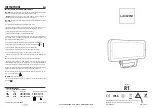
10
Troubleshooting
Problem
Possible Cause
Solution
The light will not come on.
□
The light switch is turned off.
□
Turn the light switch on.
□
The fuse is blown or the circuit breaker
is turned off.
□
Replace the fuse or turn the
circuit breaker on.
□
Daylight turn-off (photocell) is in effect.
□
Recheck after dark or turn
the “LUX” dial toward the
“ + ” position.
□
The circuit wiring is incorrect (if this is
a new installation).
□
Verify the wiring is correct.
□
The outside air temperature is close to
the same as a person’s body heat.
□
Increase the “SENS”
setting.
The light comes on during the
day.
□
The motion sensor may be installed in a
relatively dark location.
□
The light fixture is operating
normally under these
circumstances.
□
The “LUX” control is turned to the “ + ”
position.
□
Turn the “LUX” dial toward
the “ – ” position.
The light comes on for no
apparent reason.
□
The motion sensor may be sensing
small animals or automobile traffic.
□
Decrease the “SENS”
setting or reposition the
motion sensor.
□
The “SENS” control is set too high.
□
Decrease the “SENS”
setting.
□
The outside temperature is much
warmer or cooler than a person’s body
heat (summer or winter).
□
Decrease the “SENS”
setting.
□
The light fixture is wired through a
dimmer or timer.
□
Do not use a dimmer or
timer to control the light
fixture. Replace the dimmer
or timer with a standard on/
off wall switch.
The lights stay on continuously.
□
The motion sensor may be picking up a
heat source, such as an air vent, dryer
vent, or brightly painted, heat-reflective
surface.
□
Decrease the “SENS”
setting or reposition the
motion sensor.
□
The light fixture is wired through a
dimmer or timer.
□
Do not use a dimmer or
timer to control the light
fixture. Replace the dimmer
or timer with a standard on/
off wall switch.
□
The light fixture is on the same circuit
as a motor, transformer, or fluorescent
bulb.
□
Install the light fixture on
a circuit without motors,
transformers, or fluorescent
bulbs.










































